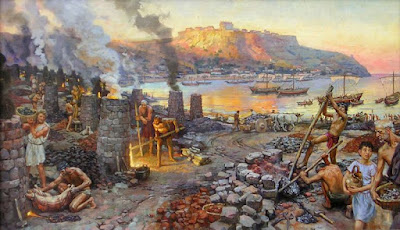Oil painting of Central American artifacts for a Nat Geo map supplement
"How has the study of Archaeological and Anthropological aspects influenced the style of Imaginative Realism in [your] Artworks?"
When I was very young I fell in love with archaeology as a result of reading in National Geographic Magazine about the discoveries of lost cities like Machu PIcchu in 1911. I majored in Anthropology (which included Archaeology) in college at University of California at Berkeley. This was a subject that interested me intellectually, but while I was studying it, I had no idea how I would connect it to my even more consuming interest in art.
After graduating college, I went briefly to art school and subsequently learned to paint and draw by reading old instructional books and getting some professional experience in the paperback field. Eventually I got an opportunity to work for National Geographic as a freelance illustrator.
When I started there, National Geographic still sent its artists and art directors to meet the archaeologists on location. On some of my first assignments I had a chance to see Rome, Tarquinia, Cerveteri, Norchia, and Populonia for an article on the Etruscans. We visited some newly discovered tombs with an archaeologist named Rick Bronson.
I wasn't thinking about a style as such. The goal in my mind was to eradicate style as much as possible and to visualize what I believed to be the vision of the archaeologist. I wanted to paint the scene as if I were a witness to lost moments of history. I was inspired by the previous National Geographic illustrators such as Tom Lovell, who I later met and corresponded with.

My method was modeled after his. I would start by reading as much as I could about the history then sketch up dozens of small thumbnail sketches. After the basic direction was worked out, we would travel to the location and go over all the details. The archaeologists and paleontologists were always incredibly helpful, as was the National Geographic staff, which includes full-time art researchers.
I had to get used to the fact that most of the work would never be seen. National Geographic is a photo magazine, not an art or illustration magazine, so the art never had a secure place, unless there was no other way to solve the problem. That meant working up full comprehensive layouts for editorial meetings to try to steal layout space away from the hundreds of dazzling photographs that had already been taken.
It was routine for entire stories to be cut after a lot of work was done. I did dozens of comprehensive studies for a story on the Roman empire in the Holy Land, but the whole story was canceled because the editor questioned the scholarship of the author. But I didn’t mind too much. It was like taking a college course and getting paid for it.
I had to get used to the fact that most of the work would never be seen. National Geographic is a photo magazine, not an art or illustration magazine, so the art never had a secure place, unless there was no other way to solve the problem. That meant working up full comprehensive layouts for editorial meetings to try to steal layout space away from the hundreds of dazzling photographs that had already been taken.
It was routine for entire stories to be cut after a lot of work was done. I did dozens of comprehensive studies for a story on the Roman empire in the Holy Land, but the whole story was canceled because the editor questioned the scholarship of the author. But I didn’t mind too much. It was like taking a college course and getting paid for it.


I wonder why National Geographic didn't make books out of the art they had. That would have been interesting.
ReplyDeleteI wonder why National Geographic didn't make books out of the art they had. That would have been interesting.
ReplyDeleteWhat a life!
ReplyDelete